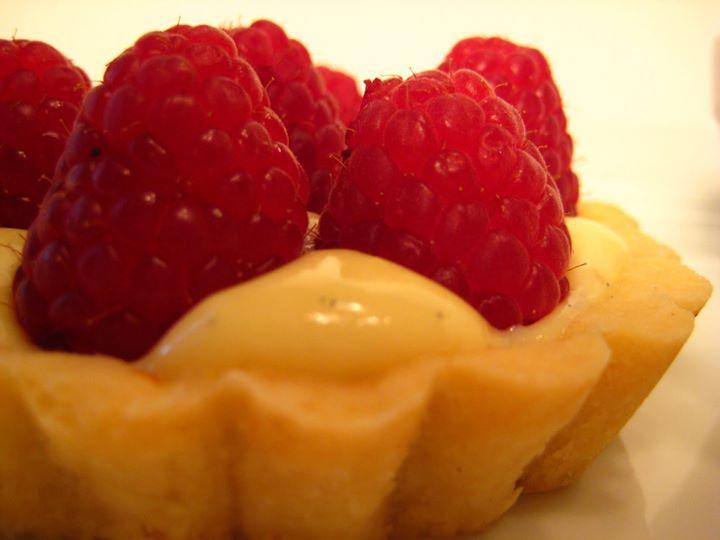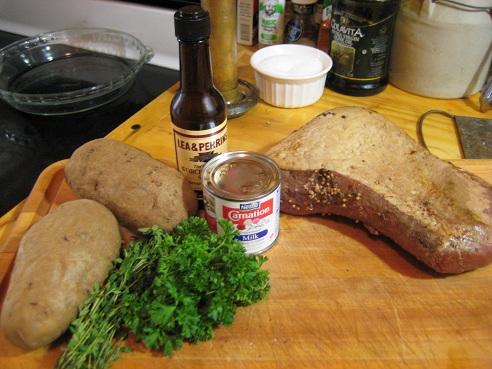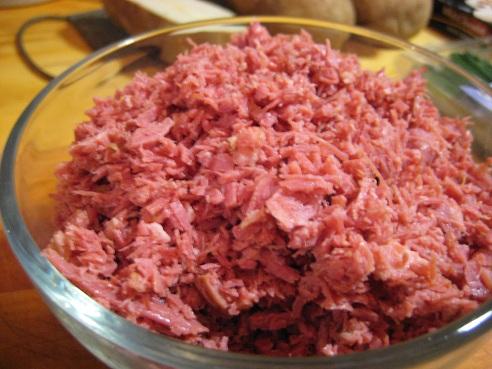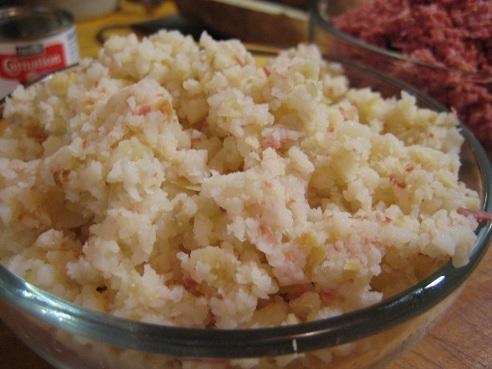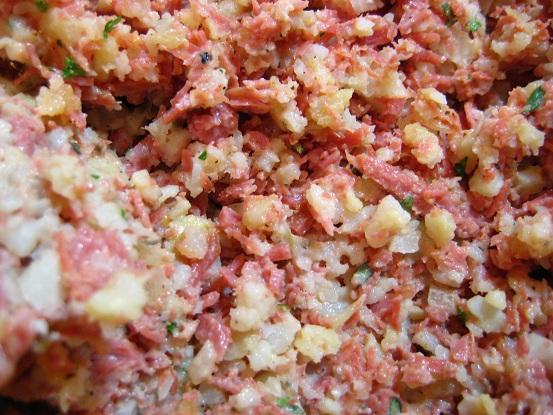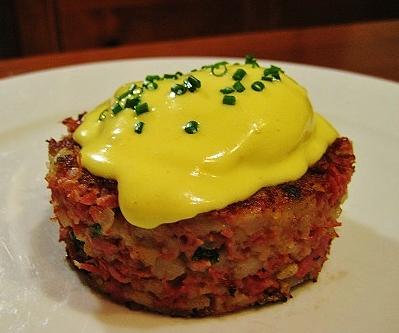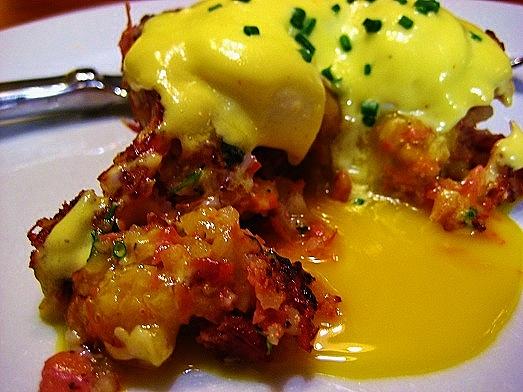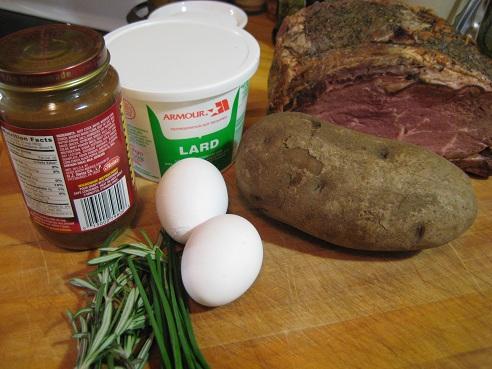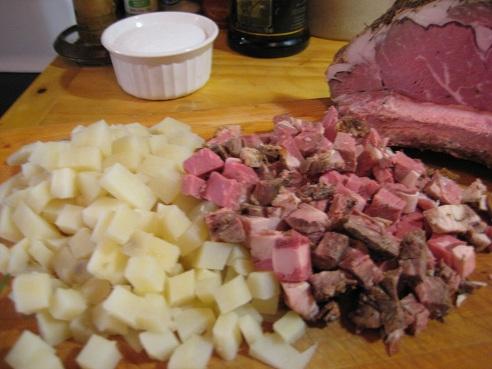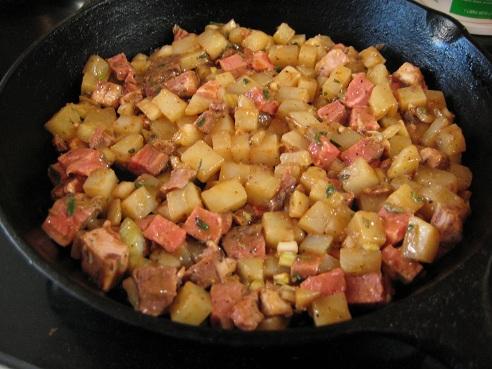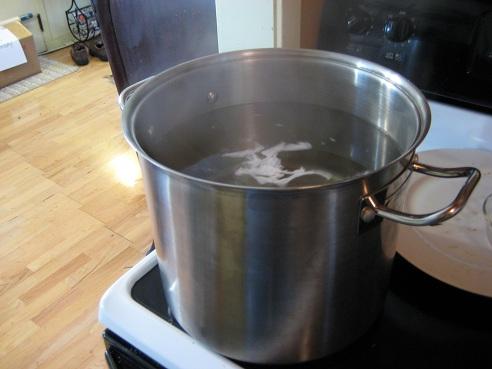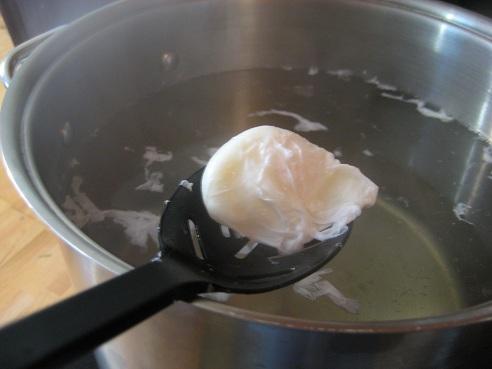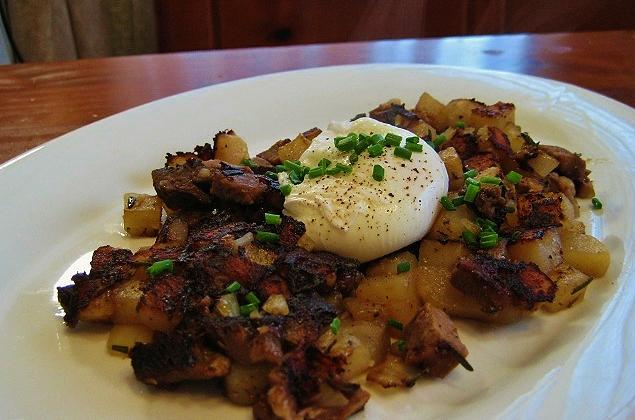-
Posts
5,035 -
Joined
-
Last visited
Content Type
Profiles
Forums
Store
Help Articles
Everything posted by David Ross
-
Has anyone ever baked a hash? I've read some recipes where they call for spreading the hash in a casserole dish and baking it. I'm thinking you could bake it until it's hot, then make some indentations in the top and crack in some eggs, then return it to the oven to bake the eggs until set.
-
When Bravo stoops to selecting "D" level, former public figures like PeeWee Herman for the Judges Panel you better get the clicker out...
-
This is really my only experience with hash. 'Creamy Chicken Hash' which I got from a Good Housekeeping cookbook. Dead simple. Diced potato, seasoned and sauteed in oil. Then some cream, which is reduced and some diced cooked chicken added after the heat is turned off just to warm through. It's good by itself, but strikes me as a sort of 'mother dish' to which many twists could be applied. Same here. Cream. I'm having trouble getting my head around the food processor shredded ingredient version of hash. The resulting texture is all wrong, and frankly it looks less than appealing. Hash is a derivative of "hacher" for a reason! Good points Linda--but I have to respectfully disagree. As I mentioned in my post, when using the food processor method, it's important to only pulse the meat and potatoes for a few seconds at a time so the hash doesn't turn into a paste. Does the mix look unappetizing in the photo? Maybe to some, but I wanted to demonstrate the difference in the textures over the "diced" hash. In terms of the final side-by-side taste test of the two, Hash #2, (aka the food processor shredded/choppe style), was far better than the more traditional Hash #1 that was diced by hand. I preferred the creaminess of Hash #2 and the mouthfeel of the texture of the hash. For nostalgic reasons, the texture of Hash #2 reminded me of the hash I ate with my Grandfather at the Depot Cafe in Twin Falls, Idaho, in the 60's. I doubt the diner cooks at the Depot Cafe used a food processor, but their hash was definately of the shredded variety and not diced. In the end, of course flavor must prevail and that's why I preferred Hash #2. It sounds like hash, while a dish of many different personalities, is the sort of dish that elicits a lot of personal preferences.
-
Wow David that's some impressive hash. I might have to give this a try. Looks like you took that recipe and spun some straw into gold there. Thanks. I was just winging it, which sometimes leads to an exceptional dish. I just had this sense when I saw the corned beef and potatoes mixed together that this was going to turn out delicious. And when I corn my own beef in March I think it will be even better!
-
I like the suggestions of adding trout or smoked fish as the meat element in a hash. You could stretch the boundaries of hash to include crab cakes. I follow the rules of the Pacific Northwest and exclusively use Dungeness crab bound by a bit of homemade mayonnaise and fresh bread crumbs, nothing else is typically included. But the addition of potato would of course make it a hash--and it would be delicious. Don't cod cakes and fish cakes include potatoes?
-
For "Hash #2," I started with a recipe for "Best Oven Hash" from the 1976 edition of the Better Homes and Garden Cookbook, (the classic over the years that has the red-checked cover enclosing pages bound with a three ring binder). While the ingredients were the simple fixins of a hash--corned beef, potatoes, onion, parsley, worcestershire sauce--I totally changed my techniques from Hash #1. The beef was braised not roasted, the potatoes baked not boiled, and the ingredients were chopped/shredded in the food processor rather than diced by hand. There was one ingredient in the recipe that mystified me--evaporated milk. I haven't used that stuff in years and the only reason I could think of using it in the hash would be to act as the "binder" to bring the meat and potatoes together, (similar to the brown gravy in Hash #1). I'd found hash recipes using cream, but not evaporated milk. Again, simple ingredients but this time the focus was on technique- I used a commercial corned beef. (I'll make my own corned beef in a few weeks in preparation for my annual St. Patrick's Day Rueben Sandwich). I braised the beef in Guiness Stout for about 8 hours. I knew the Guiness would give the beef a lot of flavor, and a bit of tang, but would it work in a hash with potatoes? I let the meat rest and chill overnight in the fridge. Instead of dicing the meat this time, I used my double-bladed food processor to shred and chop the meat. The trick is to make sure you use very short, 3-4 second, pulses. Anything more will turn it into corned beef mush Instead of boiling the potatoes, this time I roasted them in a 375 oven. These were big #1 Russet "baking potatoes" and so they took 1 1/2 hours. Baking the potatoes gives them a fuller, roasted flavor over boiled potatoes. I typically prepare potatoes this way in a dish called "Pommes de Terre Macaire." It's basically a baked potato that you chill overnight, then scoop out the flesh and saute it in butter. After the potatoes come out of the oven I let them sit to room temperature then into the fridge. Don't peel them, don't wrap them in plastic. Just let them sit overnight in the fridge to tighten up. Again, instead of dicing the potato I processed them quickly in the food processor just to a shredded/minced stage. I typically don't use a food processor for any potato dish as it spins too fast and turns the starch in the potato to glue. Here's the potato and corned beef mixed with minced onion, salt, pepper, parsley, a good dose of Worcestershire, and a 5oz. can of evaporated milk- Because evaporated milk has about 60% of the water removed, it brought the hash together without being too runny. The hash was creamy in texture, but in the end you couldn't really discern any milk or dairy flavor. This time I used a non-stick skillet rather than cast iron. And instead of lard for the oil, I used salted butter. I packed the hash into a 3" ring mold that's about 1 1/2" high and placed the ring mold on top of the melted butter in the skillet. It only took about 4-5 minutes per side to get the hash crispy and golden brown using the smaller size over the "whole skillet" hash #1. While the hash was cooking I poached the eggs, again in the huge stockpot. I had made some hollandaise ahead of time and kept it warm over a pot of simmering water. The final verdict on Hash #2? Excellent. The texture was more creamy and soft, yet you could still pickup individual bites of meat and potato. The Guiness added lots of flavor to the meat, and the hash would have been flat without the Worcestershire. Sauteeing in the ring mold was much easier to control when flipping the hash, and using a non-stick skillet was a breeze and crisped the hash much quicker than the cast iron skillet. Of course, a poached egg seems to be required when serving hash because the runny yolk breaks into that crispy hash and creates another flavor element. Hollandaise isn't required, but that really sent Hash #2 over the top. I got requests from friends and family in Portland, Sacramento and Las Vegas for Corned Beef Hash when they saw the photos. Anyone else out there use cream or evaporated milk in their hash?
-
That's great advice--and probably a lot easier than my method. I use a plate that will fit just within the inner circumference of the skillet and then flip the skillet/hash over. Sort of the upside-down move. Then I add new oil and gently slide the hash back into the skillet, browned side up, to crisp the underside. It works, but it's tricky--especially when you're flipping a pretty heavy piece of cast iron..
-
I want to eat them!
-
My first Hash dish was based on traditional recipes and included leftover Holiday prime rib, potatoes and onions. I added some bottled gravy for moisture and seasoned the hash with rosemary, thyme, salt and pepper. I prefer cooking with Russets in almost any dish that calls for potatoes. I suppose it's partly loyalty to the Russet since my Grandfather grew them in Eastern, Oregon, and my Mother comes from the heart of Idaho potato country. But I love the hearty potato flavor of the Russet over more sweet, sticky potatoes. I boiled the unpeeled potatoes in salted water and refrigerated them overnight. I keep the skin on the potatoes when boiling to act as a sort of blanket around the potato meat so it doesn't get to watery. Cooling the potato overnight helps the starch to calm back down and it makes the potato more solid when you dice it for the hash on day 2- For "Hash #1," I diced the beef, potatoes and onions. I always assumed that the ingredients should be diced based on the recipes I reviewed and my memories of eating hash, but as we'll see in my second hash dish, the "cut" of the meat and potatoes has a huge impact on the texture and flavor of the finished dish- After tossing the mix with some of the gravy, (for moisture and to act as a binder), I melted some lard into a cast iron skillet. I figured since I was doing a traditional hash dish I should use lard because that's probably the oil that cooks used years ago. In all honesty, the lard didn't add any additional flavor and butter or olive oil would have been a better choice- I wasn't overly happy with the results of the hash using the cast iron skillet. I use this skillet for searing steaks and seafood and I assumed it would give the hash that classic crispy, golden crust. I literally ended up turning and turning the hash to get some caramelization on the potatoes. Typically I only have to saute potatoes in this pan for about 10 minutes per side to get a crust on them. I realized that the addition of the gravy was keeping the hash from getting crispy, and the large dice and skillet also contributed to my problems in getting the right "finish" on my hash. I switched to a non-stick skillet and a different cut on the meat and potatoes for "Hash #2." Call me wacky when it comes to poaching eggs. As you can see, I use a huge 10-gallon pot. And that's to poach one egg!- I like to use the deepest pot I can find when poaching eggs. It's like the example of an Olympic diver--to get the best chance to show your skills, (and the best poached egg), you have to start on high and dive into the deepest water you can. (If you're worried your pot of water is too shallow, your poached egg will hit the bottom of the pool and burst). I find that eggs that are about two weeks old actually work best. I pour in about 1/4 cup of apple cider vinegar to help the egg white congeal around the egg, then swirl the water with a long wooden spoon to create an eddy in the center of the pot. (This helps the egg enrobe itself when you drop it into the water). I let the egg poach for about 5 minutes for a very runny yolk- And here's "Hash #1" with Prime Rib, Potatoes and Poached Egg-
-
One of the great things about hash, other than being delicious, is that it's an incredibly cheap and easy dish to make. I like the idea of using tangy, salty olives in hash.
-
MUTTON
-
It's a Member in either the UK or Scotland where they cherish their game, (pheasant anyone?), and the grass-fed lamb, (when the meadow isn't covered in snow!)
-
And even better I imagine with a garnish of crispy duck cracklins!
-
I think of it as a simple formula of meat and browned potatoes (hash browns must be somehow related), but I typically do associate it with beef. Also, I always put a poached egg on mine, but I don't think that's strictly necessary. Another good idea is duck hash, with cubed duck meat or, even better, coarsely shredded confit. I suppose pork is possible, but I've never seen it and it doesn't fit my standard conception of the dish. Corned beef hash is on pretty much every diner menu too, so it's most popularly associated with the dish. I think most of us define hash as an American dish whose primary ingredients are leftover roast beef and potatoes--a Diner Classic so to speak. I dug into the history books and found that the word “Hash” is derived from the French word “hachis,” or “hacher,” which means to chop. Now while the French like to take the credit for nearly every great achievement in the world of culinaria, I’m suspect that they should be the only ones to take credit for creating Hash. Certainly thousands of years ago the Romans found any number of uses for left-over meat and Native South Americans were known to be the first cultivators of potatoes. Somewhere through the ages, leftover potatoes and meat formed a relationship of Hash and one of the great dishes of mankind began an ageless marriage. In Malaysia, Hash is known as “Bergedil,” and in Latin cuisine “Picadillo,” is a version of Hash. I looked into my collection of recipes from the White House and found a recipe from 1887 during President Grover Cleveland’s administration. (Imagine Hash in the State Dining Room today). The recipe directs the cook to “moisten with beef gravy, if you have any, and cook long enough to be hot, but no longer, as much cooking toughens the meat.” (I use cooked meat that has already been tempered down to the stage of fork-tender so a long stay in the pan when I'm making Hash doesn't seem to toughen the meat). I made two types of Hash for the Cook-off--a Prime Rib and Potato Hash that I made from a combination of recipes I pulled off the Internet--and a Corned Beef and Hash recipe from the 1976 Edition of the Better Homes and Gardens Cookbook. Chi-Chi, trendy versions of Hash are apparently the choice of Celebrity Chefs, (and Celebrity Chef wannabes). During Season 6 of “Top Chef,” Cheftestant Ron Duprat crafted a dish of “Jerk Bass with Collard Greens and Rastian Hash.” (No doubt an attempt to link the Jamaican culture with ‘hash'). His Rastian Hash is a mix of 4 varieties of potato and yucca root--nary a scrap of meat in the hash. See the recipe here . As is his wont for creating incredibly lengthy preparations of simple dishes, Chef Thomas Keller, (Per Se and the French Laundry), gussies things up in his “Ad Hoc at Home,” cookbook with a dish of “Potato Hash with Bacon and Melted Onions.” Keller uses Yukon Gold Potatoes, (which I find too sweet and waxy for hash), and artisanal, applewood-smoked bacon from heritage-breed pigs. But while I make fun of the Top Cheftestants and Chef Keller, I think that updated versions of Hash, like one using duck confit, could be delicious.
-
You are clairvoyant! That's exactly what I did with one of my two hash recipes. Baked Jumbo #1 Russets for 1 1/2 hours at 375. Let them chill overnight in the fridge, (don't peel). Use them in your hash the next day. The potato has a roasted flavor and it isn't gummy like boiled potatoes can be. I'll be posting more, (including photos), of what I can call a "Baked Potato Corned Beef Hash."
-
I understand your cast-iron anxiety. I've had the same challenges frying hash in my cast iron skillet. I settled on a decent non-stick pan when I made my hash and it turned out perfectly.
-
Tongue Hash--very nice.
-
Welcome back to our reknowned eGullet Cook-Off Series. Our last Cook-Off, Bolognese Sauce, led to a spirited discussion over the intricacies of the beloved Italian meat sauce. Click here for the complete eG Cook-Off Index. Today we’re launching eGullet Cook-Off 58: Hash, the classic American diner dish. Yet what appears as a humble, one-name dish is anything but ordinary. The difficulty in defining “Hash” is exactly why we’ve chosen it for a Cook-Off—simple definitions don’t apply when one considers that Hash is a dish that transcends regional and international boundaries. The ingredients one chooses to put into their version of Hash are limitless--we aren’t just talking cold meat and leftover potatoes folks. I for one, always thought Hash came out of a can from our friends at Hormel Foods, (as in "Mary Kitchen" Corned Beef Hash). It looks like Alpo when you scoop it out of the can, but it sure fries up nice and crispy. After a few weeks of research in the kitchen, I’ve experienced a new appreciation for Hash. So start putting together the fixins for your Hash and let’s start cooking. Hash, it’s what’s for breakfast, brunch, lunch and dinner.
-
What was your oven temperature and did you bake the pizza on a stone?
-
I'm in for everything and I'll probably come in a few days early for more of Philadelphia's food offerings. I'll be part of the main course team in the kitchen.
-
So we have to agree to disagree on Beverly. My perception of Beverly is my reality, (which isn't necessarily the "right" perception or one shared with others). Her lack of self-confidence was apparent to me in a number of challenges. She was continually asking the other Chefs for guidance on her dishes, which in my view showed a lack of security in her own abilities. Maybe it wasn't so much a lack of confidence but a need to be accepted by the rest of the pack. Alpha personalities can be crappy cooks, as evidenced by big, bad, Heather. In the words of Beverly, bad karma got Heather. Maybe it was karma, maybe it was a horrific plate of beef stroganoff. While a timid Chef can craft great dishes, I'm still not overly confident that timidity will raise Beverly up ladder to the tier of Top Chef. I guess only time will tell, and that will be long after season 9 of Top Chef concludes.
-
Now I'm caught up. While I personally liked Bev, I sensed it would only be a matter of time before her nervous, anxious, insecurities caught up with her. She presented some good dishes, but really, get over your self-pity and take charge of your food and in the kitchen. We all know how intense a commerical kitchen can be, especially at the "Top" levels. Combine that with a group of talented people in a competitive environment and the weak, (aka Bev), will smell like a dead rabbit to a coyote in the Texas desert. (Well, maybe not literally). I do hope Bev continues her career in a kitchen that is conducive to her personality. She showed she has the skill, but she's got to believe that herself in order to be a "Top Chef."
-
Wow, sounds like I missed another great episode. This time it wasn't planned. I was tuck in a cheap hotel/and SEA Airport for five days due to the storm. Cheap hotels don't have Bravo. I'll have to catch the rerun.
-
Tommorrow I'm doing another cooking class at a local kitchenware store. This class is $39 per student. Most of the classes run $25-$40. My classes are limited to 16 students in a display kitchen format---meaning the students sit out front while I cook. When we do interactive classes we limit the class size to 8 so each student has the opportunity to get in the kitchen and gather around the counter. Those classes are much more hands-on and we charge about $10 per student more than a regular class. Typically about half the students spend money in the store after the class. There are about 15 Chefs that come in and teach classes---everything from basic comfort food to pastry, sushi and fresh pasta. Most of our students fall in the avid, serious home cook level. Certainly not the type of person who experiments with Modernist cuisine or compressed watermelon salads, but they aren't interested in making pot roast. The store is on the level of a Williams-Sonoma, yet locally-owned. Thus the store attracts a demographic at a level of income and interest in cuisine that justfies the fees we charge. In fact, our students see the cost of the class as a bargain compared to the knowledge they gain.

